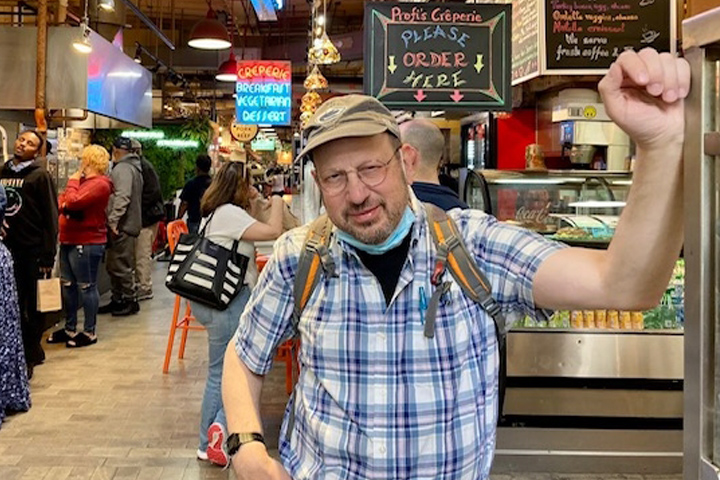The Benefit of Multiple Clinical Trials

- Joined a randomized trial and treated with FOLFIRINOX
- Proton beam radiation trial
- Distal pancreatectomy
- Recurrence and another clinical trial
I have stage IV pancreatic adenocarcinoma, in remission for about six years.
After developing fatigue and elevated blood glucose, I was diagnosed with new-onset diabetes mellitus in May 2013, when I was 56. I had the diabetes under good control with insulin over the summer, but by October I noticed that my bowel movements had changed, with steatorrhea and diarrhea, and I was increasingly fatigued. I also realized that I had lost weight. I went to the ER late one Friday, and a CT of my abdomen showed a 5 cm mass in my pancreas. My CA 19-9 level was 10,000.
I then went see Dr. Charles Yeo at Thomas Jefferson University Hospital (Philadelphia, Pennsylvania) and had Dr. Thomas Kowalski, a Jefferson gastroenterologist, do an endoscopic ultrasound-guided biopsy to confirm the diagnosis.
I am a physician so I tried to learn as much as I could about current research and ideas for treating pancreatic cancer. I consulted with other oncologist friends and “Doctor Google.”
Wanted: Clinical Trials
A CT scan of my chest, abdomen, and pelvis put my cancer at stage III, locally invasive. But the concern was that there might be “micrometastasis.” Dr. Yeo recommended initially treating with chemotherapy before doing surgery to attempt to treat these presumed metastatic cells that were not visible on the CT scan.
Dr. Lewis Rose, my first oncologist at Jefferson, also presented me with research about pancreatic cancer—and trials—as it was understood at that time. When I asked him who I should seek for a second opinion, he recommended Dr. Daniel Laheru at Johns Hopkins (Baltimore, Maryland). I was very impressed with the entire pancreatic cancer center at Hopkins (the Skip Viragh Center for Pancreatic Cancer).
The same day I was given the diagnosis, a research coordinator at Jefferson contacted me about the clinical trial they were conducting. I knew from personal experience that pancreatic cancer had a poor prognosis, and I therefore decided to enter the trial. The trial at Jefferson was for HyperAcute-Pancreas, algenpantucel-L. It was a randomized trial, and I was in the comparator arm so I received FOLFIRINOX only, not the drug being tested. I had five cycles (every two weeks) of FOLFIRINOX, with the expected side effects of nausea, fatigue, thrombocytopenia, and anemia, which were unpleasant but not intolerable.
When the study’s next step called to begin radiation therapy, I sought advice from Dr. Ursina Teitelbaum, an oncologist at Penn Medicine, University of Pennsylvania (Philadelphia) who had treated a patient of mine (an ENT physician with pancreatic cancer). It was her opinion that I should consider a clinical trial at Penn for proton beam radiation therapy. That study was conducted under the guidance of Dr. James Metz from the radiation therapy department at Penn, and I went Monday to Friday for seven weeks in early 2014.
After completing the clinical trial, in June 2014 I underwent a modified Appleby procedure (distal pancreatectomy, splenectomy, cholecystectomy, and vascular procedure to resect the celiac artery with a bypass to restore the liver blood supply) with Dr. Yeo at Jefferson Hospital.
Approximately six months after surgery, I had recurrent cancer in my left anterior cervical (neck) lymph node (confirmed by biopsy) as well as in my left adrenal gland (not biopsied). At that point—January 2015—I looked for another clinical trial. My wife Miriam read an article about Dr. Igor Astsaturov, an oncologist at Fox Chase Cancer Center in Philadelphia that highlighted his heroic research efforts to try and save his wife after she was diagnosed with pancreatic cancer. Miriam said that if he would go to those heroic efforts for her, he would do the same for me. Dr. Astsaturov gave me hope and instilled confidence. Ultimately, he helped me find the trial in 2015 that worked for me.
In February 2015 I started on a clinical trial using ipafricept (OMP54F28), a recombinant fusion protein which inhibits WNT signaling by blocking WNT ligands. Results of this study can be found here. I was also on gemcitabine and Abraxane. The gemcitabine together with the ipafricept caused a hemolytic uremic syndrome, a serious kidney problem that causes anemia, high blood pressure, edema, and compromised renal function. When I stopped the gemcitabine, the problem resolved. Abraxane (nab-paclitaxel) was associated with a “stocking-glove” area numbness and peripheral neuropathy, which continues to the present time.
I stopped taking gemcitabine in December 2016 and Abraxane in 2017. I remained on ipafricept for five years, until January 2020. I have been off chemotherapy since then.
During treatment I had regular monitoring for CA 19-9 levels, CT scans, and other blood markers. As part of the clinical trial I had regular bone density scans and bone breakdown marker tests to monitor for bone-related side effects from the ipafricept.
Life After Treatment
My life is good. After finishing the trial with ipafricept I have traveled with my wife (a trip to London in 2018, and two trips to Israel to see family in 2018 and 2019). I take university classes at Temple University and Delaware Valley University (history, science, and languages—a hobby of mine).
I no longer work in medicine, but I attend weekly grand rounds at our local hospital. I volunteer for PanCAN, where I am a support person for people and families navigating the cancer pathway. I also am working as a volunteer with the American Cancer Society Cancer Action Network on a research project to help more persons diagnosed with cancer find appropriate clinical trials. I walk three to five miles daily and try to keep as active a social life as COVID permits. By the way, I have received a COVID vaccine and boosters and recommend that others do the same. I am very glad to be alive.






